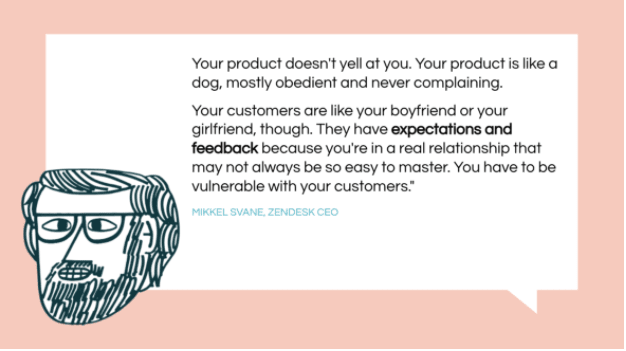
For startup founders, passion for the product comes naturally. You’re probably your first customer, and so it’s easy to build something that you think customers will want. But when it comes to growing your business, designing great products requires more than your own intuition. It requires establishing a customer-obsessed mindset.
In my first startup, we were building a platform to buy and sell solar renewable energy credits. It was a nascent market driven by new laws requiring the adoption of solar energy. Our first thought was to build an online auction for buyers and sellers, like eBay, but for solar energy. Simple. If you build it, they will come, right?
Cultivating a relationship with your customers can be incredibly difficult. It takes diligence, patience, and processes that can be hard for founders—and at the heart of it, it’s all about being vulnerable and committed to listening to customers. We told everyone we were a startup trying to figure this business out, but in a way that was open, honest, and transparent.
A few months after we launched, we had a small number of buyers and sellers, but the hockey stick growth wasn’t happening. I had started my career in customer support, so one of the first things I did was set up a toll-free number and support email. We published that everywhere and took every phone call and every email.
We listened. And we learned. We learned how difficult it was for home and small business owners to register their solar energy systems. This led us to develop a subscription service along with our trading platform which made it easier for our users to do this. Eventually, one in seven installations in the market we served was registered on our platform.
Once we created that service, we learned more about how difficult it was for solar installers to explain everything to their customers. So we developed a channel offering our service alongside their installation. We then developed a network of over 300 partners who we initially thought we were competing with for business.
Sometimes, it took us a long time to listen. We were brazen in our thinking that all transactions would happen online when we courted large energy companies to be buyers in our marketplace. We were an online technology company incubated at Stanford… so when buyers suggested that we transact with them over AOL Instant Messenger, we didn’t take it seriously. But once we listened, we completed our business model and reached the scale to be profitable.
In these three different relationships, what we thought going in was very different from how our business evolved. When you’re building a startup, there is not a lot of margin for error. Each piece that came together made the difference between success and failure.
So why is being vulnerable with your customers vital to your startup’s future? Simply because those conversations—as awkward and painful as some of them will be—generate invaluable feedback that will help you build a product that truly serves your users’ needs. Here are a few ways to do this:
Talk to every customer
As the face of the company, the founder needs to be available to those early customers. Give out your email or WhatsApp so customers know they can talk to you. Model this behavior in front of your team, however small or large.
Pay attention to negative feedback
Check your social media and online reviews, and investigate every complaint. Those gripes are gifts, and they’re how your customers will teach you. Dig into the details to find meaningful insights, and don’t ignore them because they tell a story you don’t want to hear or they’re hard to address. Pay attention for precisely those reasons.
Amplify the voice of your users
Don’t stop with just talking to customers—make their voices heard. For example, you could use software like Airtable or Trello to create internal dashboards that display customer feedback (as well as other metrics). Also, consider a Slack integration where customer issues are automatically posted to a shared Slack channel—it’s a great way to get product managers, engineers, and other employees thinking about the customer experience.
Base product iterations on customer feedback
When developing your product roadmap (and later, when you’re hashing out the product requirements), be sure to incorporate user feedback. Analyze how they’re using your product, and embrace agile development so you can shift direction quickly without losing large amounts of development time.
4 ways to act on customer feedback as a founder
We recently started a Zendesk for Startups Program where we share strategic advice with an exclusive community of up and coming startups. Here are four essential tips we always share with founders for getting customer experience right:
- Follow-up with users who give you a negative rating. This is a great way to build trust with customers and retain their business.
2. Analyze bad ratings that include comments. While it might be tempting to spend time on the glowing reviews, you’ll garner more actionable information from those customers who are unhappy with your product or service.
3. Meet every week to discuss customer satisfaction outcomes. Set time aside for the team to analyze negative comments and brainstorm about ways to remedy the underlying causes.
4. Group negative comments by cause—and look for trends. Doing this will help you identify problem areas such as long ticket resolution times, poor product documentation, or bugs/unexpected product behavior.
The next time you’re debating how to balance the time you’re spending on your product vs your customers, remember this quote from Zendesk’s CEO & Founder, Mikkel Svanne:

Don’t forget to talk to your customers!
Get the TNW newsletter
Get the most important tech news in your inbox each week.





